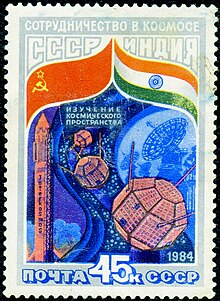Bhaskara (satellites)
This article relies largely or entirely on a single source. (February 2011) |
| Mission type | Experimental Remote Sensing Earth Obsservation Satellite |
|---|---|
| Mission duration | 10 years |
| Spacecraft properties | |
| Spacecraft type | Uncrewed |
| Manufacturer | |
| Launch mass | 444 kilograms (979 lb) |
| Power | 47 watts |
| Start of mission | |
| Launch date | 7 June 1979 IST |
| Rocket | C-1 Intercosmos Launch Vehicle |
| Launch site | Kapustin Yar |
Bhaskara-I and -II were two satellites built by the Indian Space Research Organisation that formed India's first low-Earth orbit Earth observation satellite. They collected data on oceanography and hydrology. The satellites are named after the ancient Indian mathematicians Bhāskara I and Bhāskara II.[1]
Bhaskara-I
[edit]Bhaskara-I, weighing 444 kg at launch, was launched on 7 June 1979 from Kapustin Yar aboard the Intercosmos launch vehicle. It was placed in an orbital perigee and apogee of 394 km and 399 km at an inclination of 50.7°.[2] The satellite consisted of:
- Two television cameras operating in visible (600 nanometre) and near-infrared (800 nanometre) that collected data related to hydrology, forestry and geology.
- Satellite microwave radiometer (SAMIR) operating at 19 and 22 GHz for study of ocean-state, water vapour, liquid water content in the atmosphere, etc.
- An X-ray sky monitor operating in 2-10 keV energy range, to detect transient X-ray sources and monitor long-term spectral and intensity changes in the X-ray sources.
| Mission type | Experimental Remote Sensing Earth Observation Satellite |
|---|---|
| Mission duration | 10 years (Re-Entered in 1991)[3] |
| Spacecraft properties | |
| Spacecraft type | Uncrewed |
| Manufacturer | ISRO |
| Launch mass | 444 kilograms (979 lb) |
| Power | 47 watts |
| Start of mission | |
| Launch date | 20 November 1981 IST |
| Rocket | C-1 Intercosmos Launch Vehicle |
| Launch site | Volgograd Launch Station |
Bhaskara-II
[edit]The satellite provided ocean and land surface data. It orbited at 541 × 557 km with an inclination of 50.7°.
While one of two onboard cameras malfunctioned, the satellite still sent back more than two thousand images. Housekeeping telemetry was received until re-entry in 1991.[4]

See also
[edit]References
[edit]- ^ Bhaskara NASA 16 September 2017
- ^ Bharat-rakshak.com Indian satellite systems Archived 16 May 2007 at the Wayback Machine
- ^ "Bhaskara-II : ISRO". Archived from the original on 12 July 2019. Retrieved 10 January 2020.
- ^ "Earth Observation Satellite". Archived from the original on 21 January 2013. Retrieved 25 February 2013.


